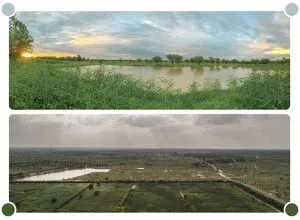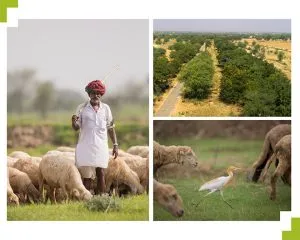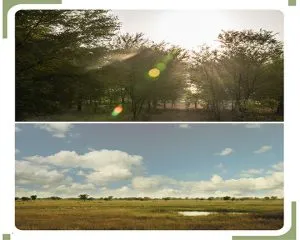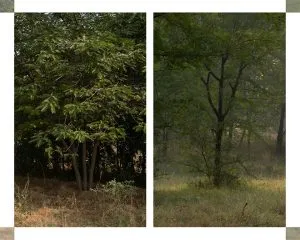 “To some generations, much is given. Of other generations much is expected.” — Franklin D. Roosevelt
“To some generations, much is given. Of other generations much is expected.” — Franklin D. Roosevelt

or centuries, we human beings have exploited our planet catastrophically, yet, for most of us, the air continues to be unbreathable, water undrinkable, the food inedible, and depression has become the leading cause of disability worldwide. Perhaps our civilisation has outgrown the systems it had put in place to secure its future? Be it the “short-termism” in capitalism, centralisation of authority or information, or industrial age education and work systems — all are response mechanisms from a period of scarcity, bound to lose their relevance in this
era of abundance. The woeful fragility and irrelevance of these structures were exposed by a virus a 100 millionth our size; imagine then the cataclysmic consequences of something as immense as climate change!
The economic and social devastation this pandemic continues to wreck is a fair warning of a doomsday, just as it is an opportunity like never before to collaborate, and motivate societies to embrace “
long-termism” and invest in socially and environmentally regenerative developmental narratives and structures that enable self-sufficiency.
 Consider India
Consider India; the
5th largest economy in the world, also home to
21 of its 30 most polluted cities with as much as
70 percent of our surface water unfit for consumption. The Global Hunger Index ranks us at 94 out of 107 countries. With a score of 27.2,
India has a level of hunger that is deemed “serious” yet continues to be one of the largest exporters of food. These paradoxes beg some questions. What is development? Who is developing? At what cost? And most importantly, who ultimately bears that cost? As we move into an era of AI, creative economies, and singularity — clearly, 1.3 billion people could be our greatest resource or a time bomb waiting to explode.
Our fundamentals are so gravely compromised, that our developmental narratives, in particular, how we build urban environments and their role in cultivating human potential, require a major course-correction, not merely an adjustment. We are all beginning to realise the macro effects of
water privatisation,
industrial food production, and distribution systems. Consumerism-induced consumption resulting in an unprecedented increase in energy requirements and environmental colonisation is not sustainable, and the
impact of the construction industry on climate-disasters is well documented. There seems to be a structural flaw: Capitalism makes urban development obsessed with efficiency and dominance hierarchies, and individualism puts the needs of some individuals above communities, and therefore ecologies come last in the list of priorities. So what if we could completely reverse this by creating decentralised developmental narratives that consider the needs of our ecology, communities, individuals, and the efficiency of its systems (in that order)? In this, we have a good chance at reversing decades worth of damage and the opportunity to bring us back from the edge.

By using the
Dhun project, as a case study in progress, perhaps we can elaborate on the potential of reimagining urban planning and the policies we could put in place to achieve holistic developmental goals. The
Dhun Project aspires to create a microcosm in a 500-acre ecological reserve, comprising of living, working, learning, recreational and research spaces, for a community that can support itself. Situated on the outskirts of Jaipur, India, the project started its journey on degenerated barren land, with no water source. The priority was to address basic fundamentals of life — water, food, and air, which are considered to be shared resources of the community, and therefore, the size of the settlement is determined by what the land can support in perpetuity while being off the grid.
Over the past six years, before the commencement of any structural work, the team has planted over 270,000 local trees, used permaculture to grow produce, and built robust water systems that harvest over 400 million litres of rainwater. Using hyper-local materials like lime, reclaimed stone and rammed earth, along with vernacular methodologies, skill sets, and craftsmanship, they are creating a thermodynamically efficient, “no-cement” low carbon footprint, regenerative built habitat. By leveraging collective human consciousness and wisdom through exponential technologies and integrating ancient knowledge systems, they are developing contextually relevant structural frameworks for education, commerce, recreation, and the workplace. It aims to build a physical and social environment that provides people with freedom, opportunities, and access to global ecosystems to realise their truest potential.

There are modules to develop polymath thinking and learning through multidisciplinary and inter-age collaborations on real-time projects. “Co-parent trees” and “co-create waterbodies” initiatives built on game theory offered as plug and play models to contribute to local ecology, “community-led economic nutrition for incubation programmes,” “designing cognitive environments to enhance physical potential,” “pandemic proof supply chains and planning principles,” and the use of “carbon-credit currency” are some examples of their unconventional approach. By thinking about consumption and available resources in fundamentally different ways,
Dhun is re-engineering capital requirements and barriers to entry for such large scale projects. Given its fundamental value proposition and relevance in current times, it hopes to make the model financially sustainable and scalable. Enterprises such as Dhun could be a new foundation to fully realise what is possible in the realm of living development practices. When expanded, it could create a decentralised network of regenerative futuristic settlements, that reimagine consumption and leverage untapped human potential, collective heritage, diversity, and exponential technologies to bring self-sufficiency to communities without costing them their environments or identities.
Recognising systemic immunity

ut projects such as Dhun, often face “systemic immunity” where their approach to development is at odds with regulatory frameworks. Case in point, initiatives for regenerating local ecologies that make projects self-sufficient on a fundamental level, is not “accepted” as development. Financial institutions tend to have a unidimensional understanding of returns. Their mandate, for example, will make it easier for them to fund commercial projects that use 60 percent of land area vis a vis those that choose to build on less than 15 percent of land even if that model ensures long term societal and environmental sustainability. Dhun is just one example. With worldwide recognition, and increased sanctioning of public and private funds for “
UN Sustainable Development Goals,” it is primarily the inertia and lethargy of regulatory systems to experiment and adapt to changing needs, outmoded ways of thinking (developmental narratives inherited from practices built in response to a time of scarcity not one of surplus) and red tape, that make it difficult for the private sector to develop whole systems business models which address elemental public needs. More time passes, more irreversible damage is unwittingly caused.

A whole system thinking approach to development is warranted and there is plenty that can be done.
Long term holistic thinking: Government investments, priorities, policies, and non-negotiables ought to be measured in long term 3P (People, Product, Process) returns. Business models that address fundamental public needs, once their potential 3P impact is validated by domain experts, could be given a free hand to build their own methodologies so long as they are achieving meta goals for holistic development defined and enforced by the government. Most innovative ideas require the most flexible ecosystems e.g., recognising context-specific learning curriculums, building codes based on local ecologies, legal frameworks to facilitate crowd pooling of resources for large-scale community projects like accepting the
tokenisation in real estate development. Governments can help facilitate change in the class of capital being used in urban development, thereby, being instrumental in championing habitats developed by the people, of the people and, for the people.
 Government’s role as a coach and compass:
Government’s role as a coach and compass: It is the communities themselves who can best define their problems and often devise the most creative and resource-efficient solutions. Consider the example of “
I Love Jaisalmer”; a community initiative responsible for Jaisalmer’s largest cleanliness and conservation drive or the rain-fed communal farming system of the “khadins” practiced by local communities in the Thar desert. Governments, through virtual centers, could provide communities access to network, intellectual, and financial capital, thereby setting community projects for success. Using technologies like blockchain, governments can enforce accountability all the while creating paradigm shifts and fostering decentralised models and distributed authority.
Incentivising private participation: Governments could play a massive role in creating positive feedback loops in society for doing good at a societal level. Many available technologies could objectively create social pedigree and measurable incentives for doing good, e.g., assigning carbon credit ratings based on a multitude of lifestyle use factors and choices, that could also be used as currency for tax breaks. Financially incentivising reuse, zero waste, conservation of biodiversity, preserving ancient knowledge systems, skill transfer, and local job creation could go a long way towards increasing private participation in solving large scale public problems.
It cannot be emphasised enough that we are at a crossroads, our futures dependent on how soon we stop using archaic response mechanisms created for a time that has been rendered obsolete. Our willingness to connect, collaborate and co-create and, our ability to adapt exponential technologies to create solutions is what will ensure we don’t engender a few victors at the cost of many unfortunate losers, our planet included.
The views expressed above belong to the author(s). ORF research and analyses now available on Telegram! Click here to access our curated content — blogs, longforms and interviews.



 “To some generations, much is given. Of other generations much is expected.” — Franklin D. Roosevelt
“To some generations, much is given. Of other generations much is expected.” — Franklin D. Roosevelt

 By using the
By using the  There are modules to develop polymath thinking and learning through multidisciplinary and inter-age collaborations on real-time projects. “Co-parent trees” and “co-create waterbodies” initiatives built on game theory offered as plug and play models to contribute to local ecology, “community-led economic nutrition for incubation programmes,” “designing cognitive environments to enhance physical potential,” “pandemic proof supply chains and planning principles,” and the use of “carbon-credit currency” are some examples of their unconventional approach. By thinking about consumption and available resources in fundamentally different ways,
There are modules to develop polymath thinking and learning through multidisciplinary and inter-age collaborations on real-time projects. “Co-parent trees” and “co-create waterbodies” initiatives built on game theory offered as plug and play models to contribute to local ecology, “community-led economic nutrition for incubation programmes,” “designing cognitive environments to enhance physical potential,” “pandemic proof supply chains and planning principles,” and the use of “carbon-credit currency” are some examples of their unconventional approach. By thinking about consumption and available resources in fundamentally different ways,  A whole system thinking approach to development is warranted and there is plenty that can be done.
Long term holistic thinking: Government investments, priorities, policies, and non-negotiables ought to be measured in long term 3P (People, Product, Process) returns. Business models that address fundamental public needs, once their potential 3P impact is validated by domain experts, could be given a free hand to build their own methodologies so long as they are achieving meta goals for holistic development defined and enforced by the government. Most innovative ideas require the most flexible ecosystems e.g., recognising context-specific learning curriculums, building codes based on local ecologies, legal frameworks to facilitate crowd pooling of resources for large-scale community projects like accepting the
A whole system thinking approach to development is warranted and there is plenty that can be done.
Long term holistic thinking: Government investments, priorities, policies, and non-negotiables ought to be measured in long term 3P (People, Product, Process) returns. Business models that address fundamental public needs, once their potential 3P impact is validated by domain experts, could be given a free hand to build their own methodologies so long as they are achieving meta goals for holistic development defined and enforced by the government. Most innovative ideas require the most flexible ecosystems e.g., recognising context-specific learning curriculums, building codes based on local ecologies, legal frameworks to facilitate crowd pooling of resources for large-scale community projects like accepting the  Government’s role as a coach and compass: It is the communities themselves who can best define their problems and often devise the most creative and resource-efficient solutions. Consider the example of “
Government’s role as a coach and compass: It is the communities themselves who can best define their problems and often devise the most creative and resource-efficient solutions. Consider the example of “ PREV
PREV

